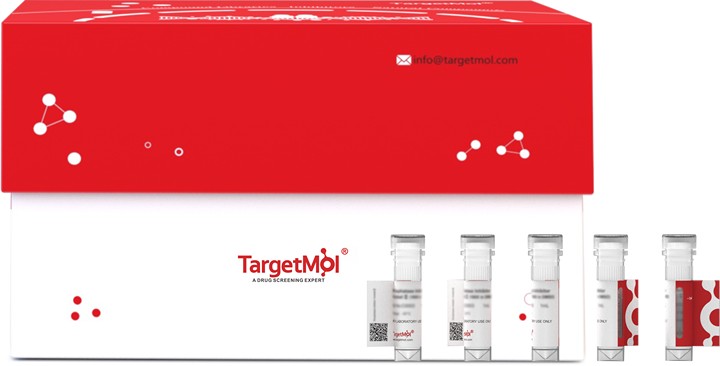 Your shopping cart is currently empty
Your shopping cart is currently empty
Gasdermin-A3 Protein, Mouse, Recombinant (His)
Precursor of a pore-forming protein involved in the transition from catagen to telogen at the end of hair follicle morphogenesis. This form constitutes the precursor of the pore: upon cleavage, the released N-terminal moiety (Gasdermin-A3, N-terminal) binds to membranes and forms pores, triggering cell death.; Pore-forming protein that causes membrane permeabilization and pyroptosis. Released upon cleavage in vitro of genetically engineered Gsdma3, and binds to membrane inner leaflet lipids. Homooligomerizes within the membrane and forms pores of 10-15 nanometers (nm) of inner diameter, triggering pyroptosis. Binds to membrane inner leaflet lipids, including bisphosphorylated phosphatidylinositols, such as phosphatidylinositol (4,5)-bisphosphate, as well as phosphatidylinositol (3,4,5)-bisphosphate, and more weakly to monophosphorylated phosphatidylinositols. Also binds to bacterial and mitochondrial lipids, including cardiolipin, and exhibits bactericidal activity. The functional mechanisms and physiological proteases that cleave and activate this pore-forming protein are unknown (Probable). Plays a role in the transition from catagen to telogen at the end of hair follicle morphogenesis, possibly by regulating hair follicle stem cell niche maintenance. Also required for mammary gland development.

Gasdermin-A3 Protein, Mouse, Recombinant (His)
| Pack Size | Price | USA Warehouse | Global Warehouse | Quantity |
|---|---|---|---|---|
| 5 μg | $105 | 20 days | 20 days | |
| 10 μg | $169 | 20 days | 20 days | |
| 20 μg | $283 | 20 days | 20 days | |
| 50 μg | $428 | 20 days | 20 days | |
| 100 μg | $590 | 20 days | 20 days | |
| 200 μg | $913 | 20 days | 20 days | |
| 500 μg | $1,620 | 20 days | 20 days | |
| 1 mg | $2,530 | 20 days | 20 days |
Product Information
| Biological Activity | Activity has not been tested. It is theoretically active, but we cannot guarantee it. If you require protein activity, we recommend choosing the eukaryotic expression version first. |
| Description | Precursor of a pore-forming protein involved in the transition from catagen to telogen at the end of hair follicle morphogenesis. This form constitutes the precursor of the pore: upon cleavage, the released N-terminal moiety (Gasdermin-A3, N-terminal) binds to membranes and forms pores, triggering cell death.; Pore-forming protein that causes membrane permeabilization and pyroptosis. Released upon cleavage in vitro of genetically engineered Gsdma3, and binds to membrane inner leaflet lipids. Homooligomerizes within the membrane and forms pores of 10-15 nanometers (nm) of inner diameter, triggering pyroptosis. Binds to membrane inner leaflet lipids, including bisphosphorylated phosphatidylinositols, such as phosphatidylinositol (4,5)-bisphosphate, as well as phosphatidylinositol (3,4,5)-bisphosphate, and more weakly to monophosphorylated phosphatidylinositols. Also binds to bacterial and mitochondrial lipids, including cardiolipin, and exhibits bactericidal activity. The functional mechanisms and physiological proteases that cleave and activate this pore-forming protein are unknown (Probable). Plays a role in the transition from catagen to telogen at the end of hair follicle morphogenesis, possibly by regulating hair follicle stem cell niche maintenance. Also required for mammary gland development. |
| Species | Mouse |
| Expression System | E. coli |
| Tag | N-6xHis |
| Accession Number | Q5Y4Y6 |
| Synonyms | Gsdma3,Gsdm3,Gasdermin-A3,Gasdermin-3 |
| Amino Acid | MHEDFKTLKEEVQRETQEVEKLSPVGRSSLLTSLSHLLGKKKELQDLEQKLEGALDKGQKVTLEALPKDVLLSKDAMDAILYFLGALTELTEEQLKILVKSLEKKILPVQLKLVESTLEQNFLQDKEGVFPLQPDLLSSLGEEELTLTEALVGLSGLEVQRSGPQYAWDPDTRHNLCALYAGLSLLHLLSRKSNALTYCALS |
| Construction | 263-464 aa |
| Protein Purity | > 90% as determined by SDS-PAGE. |
| Molecular Weight | 26.6 kDa (predicted) |
| Endotoxin | < 1.0 EU/μg of the protein as determined by the LAL method. |
| Formulation | If the delivery form is liquid, the default storage buffer is Tris/PBS-based buffer, 5%-50% glycerol. If the delivery form is lyophilized powder, the buffer before lyophilization is Tris/PBS-based buffer, 6% Trehalose, pH 8.0. |
| Reconstitution | Reconstitute the lyophilized protein in sterile deionized water. The product concentration should not be less than 100 μg/mL. Before opening, centrifuge the tube to collect powder at the bottom. After adding the reconstitution buffer, avoid vortexing or pipetting for mixing. |
| Stability & Storage | Lyophilized powders can be stably stored for over 12 months, while liquid products can be stored for 6-12 months at -80°C. For reconstituted protein solutions, the solution can be stored at -20°C to -80°C for at least 3 months. Please avoid multiple freeze-thaw cycles and store products in aliquots. |
| Shipping | In general, Lyophilized powders are shipping with blue ice. Solutions are shipping with dry ice. |
| Research Background | Precursor of a pore-forming protein involved in the transition from catagen to telogen at the end of hair follicle morphogenesis. This form constitutes the precursor of the pore: upon cleavage, the released N-terminal moiety (Gasdermin-A3, N-terminal) binds to membranes and forms pores, triggering cell death.; Pore-forming protein that causes membrane permeabilization and pyroptosis. Released upon cleavage in vitro of genetically engineered Gsdma3, and binds to membrane inner leaflet lipids. Homooligomerizes within the membrane and forms pores of 10-15 nanometers (nm) of inner diameter, triggering pyroptosis. Binds to membrane inner leaflet lipids, including bisphosphorylated phosphatidylinositols, such as phosphatidylinositol (4,5)-bisphosphate, as well as phosphatidylinositol (3,4,5)-bisphosphate, and more weakly to monophosphorylated phosphatidylinositols. Also binds to bacterial and mitochondrial lipids, including cardiolipin, and exhibits bactericidal activity. The functional mechanisms and physiological proteases that cleave and activate this pore-forming protein are unknown (Probable). Plays a role in the transition from catagen to telogen at the end of hair follicle morphogenesis, possibly by regulating hair follicle stem cell niche maintenance. Also required for mammary gland development. |
Dose Conversion
Calculator
Tech Support
| Size | Quantity | Unit Price | Amount | Operation |
|---|

Copyright © 2015-2026 TargetMol Chemicals Inc. All Rights Reserved.



